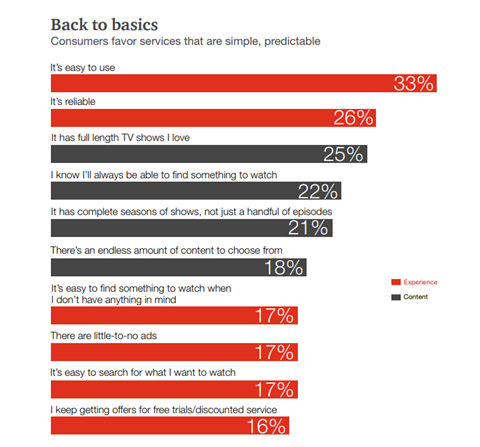A seamless user experience has surpassed the belief ‘content is king’ with audience retention, engagement and discoverability critical for success.

Content plays an integral role in the success of a video service, but a recent survey by PwC found new media company valuations have indicated good user experience (UX) delivers profits and audience retention ahead of its core content offering.
The PwC report, named report Streaming Ahead: Making UX and content strategy work together, says: “2019 marks the next phase of the streaming war, as more companies enter the fray in an attempt to wrestle consumer attention and dollars away from incumbents.”
It examines the union of user experiences and content strategies, finding that good user experience is surpassing the importance of content. “Convenience drives usage,” it explains, and consumers using both pay-TV and SVOD services have been overwhelmed by access to large amounts of content with confusing and crowded user interfaces (UI) often deterring from content consumption and net subscriptions.
“In today’s competitive and cluttered video market, being favoured can mean greater loyalty and increased usage,” writes PwC.
“As such, in addition to carrying a wide variety of desirable content, video services must also give their users a positive viewing experience that’s easy and reliable.”
The report, which was published in March, surveyed 1,000 OTT users between the age of 18-64 who are based in the US and have access to the internet to watch video on-demand content.
Clarity in a crowded market
Broadcasters, OTT platforms and content aggregators are on the timely quest to offer the most compelling, engaging and intuitive user experiences, according to analysts who spoke to IBC365.
Ampere Analysis research director Guy Bisson tells IBC365 the greatest challenge for broadcasters and platform provides is to create a seamless UX with an integrated UI that aggregates multiple content applications.
He explains that the demand is coming from audiences and non-linear channels are forced to address these challenges which creates greater opportunities for monetising and engaging with loyal viewers and attracting new subscribers.
Says Bisson: “The benefits of getting the UX right for an operator are increased loyalty, higher spend and a lower churn of customers as well as an increased brand appreciation for the platform itself and the partners providing content.
“Those engaged with the UI spend more money [on the platform] and watch more TV.”
The billion-dollar content race
Netflix spent $8 billion on content in 2018, PwC estimates its spend could climb to $15 billion this year with exclusive and original content expected to bring in new subscribers.
It found: “The competition for subscribers is already fierce and it should only continue to escalate as new services launch from several media giants. Thus, the need for exclusive and original content has never been more important.”
36% of respondents said they had subscribed to a new video service just to watch a programme only available on that service, while the usability of the interface and reliability of the services were the leading responses consumers gave in favouring a service, 33% and 26% respectively.

The video streaming market has become more saturated and will continue to do so throughout 2019 with Disney and Apple among those with plans to enter the video on-demand market.
TV Strategies principal analyst and consultant Steven Hawking says the challenges for a seamless UX is often non-technical with platforms struggling to remain authentic to its core brand.
“A good UX is fundamental to engagement and if users can’t do what the expected experience promises to do, the consumer will go elsewhere,” he explains.
“Poor navigation and forced actions are often enough. Providers who know that their offerings have no alternatives are sometimes the worst offenders.”
According to PwC survey respondents the usability and overall experience are the factors which drive value and ultimately inform the consumers decision-making process around new video service subscriptions.
Supply and demand
PwC’s report also notes that the price point was important in retaining subscriptions and the intrusiveness of the platform remained the most influential factors.
Futuresource principal analyst Simon Forrest claims broadcaster’s user experience must be “slick,” with the availability of more content than ever before: “The UI’s primary function is to deliver content and programming they wish to watch quickly and efficiently.”
He points to voice control as a way to accelerate a seamless UX journey: “A good implementation effectively enables users to short cut the UI by presenting them with directly relevant content. The added benefit is the user does not have to type in complex search terms, misspelling of which results in bad results.”
Recommendation engines are integral to ensure the voice feature works successfully, Forrest explains: “These work in the background, aggregating relevant content based upon what users have watched before, and present this within the UI ahead of other programmes.”
The research found that content remains the great differentiator: “Above all, audiences demand access to their series and films of interest. Content affiliation with a streaming service brand or legacy cable network is declining in importance.”
The changing landscape of SVOD services today means global media companies are working to gain audience traction with a wide breadth of licensed content from networks and studios.
UX considerations:
- Retention and favouritism are largely inspired by usability and experience.
- A strong UX hinges on viewers easily being able to find exactly what they’re looking for.
- When a viewer is in browsing mode, it should be about the platform or content finding them, not the other way around.
- Consumers need a user interface that helps and guides them through an enjoyable experience.
- Expanded browsing options, such as searching by mood or length of content.
Clever content discovery
Media and entertainment companies are forced to diversify and focus on its UX to capitalise on value in today’s market where consumers preferences and disruptions to the business model are increasingly crowding the competitive landscape.
PwC found viewers are interested in browsing options beyond the norm, as such harnessing technology and using data to retain and attract users is critical.
The report concludes: “The presence of artificial intelligence (AI) in the world of streaming has become more and more ubiquitous and for good reason – the best algorithms can provide adaptable solutions that prove helpful for both businesses and users.”
Some, 70% of respondents said searching for content by mood and 65% by length of content would improve the personalised UX.
The research indicates while recommendations are important, they’re not everything: “Consumers are much more intentional than one might realise, spending an equal amount of time looking for specific piece of content as they do browsing for something new to watch.”
Bisson explains: “While drive may come from the customer there is equal drive for those proving the content because of the great benefits they can bring them, which means more money, a longer customer lifetime and greater loyalty.”
Whilst voice may solve discoverability in a non-linear environment it complicates the content discovery method, Bisson said because the users journey becomes proactive rather than passive.
“With voice it is more about what you want to watch and where it might fall down is in chance discovery.” He adds.
Hawking argues the impact of voice is “now and not in the future. No matter whether the UX is voice or tactile, the result that the consumer expected should be the same.”
The UX differs upon the UI, size of screen and the device being used to access the service. Whilst broadcasters are working hard to create a seamless UX across multiple devices.
Forrest says: “Future UX will likely use advanced voice control, identifying the user via audio fingerprint technology, to avoid the problems associated with logging into individual services.
“Furthermore, audio processing algorithms are close to recognising tone and inflexion in voice, which can be employed to recognise not just the individual but also identify content that is appropriate to the user’s emotional state.”
Analysts agree the industry is not quite at a superior UX offering yet, however the rapid change of the industry and content partnerships, consumers will demand more effortless and integrated UIs.
Forrest suggests: “Broadcasters can improve the UX by consolidating the index of content across several services, as they have done in the UK, with new services, such as BritBox, working to deliver a more seamless experience.”
























No comments yet